Menus
- 20 years under the sign of "total control"
- Discreet developments
- In search of control…. partiel
- Conclusion
20 years under the sign of "total control"
1992 saw the appearance of the very first CBR Fireblade, cubing 893 cm3 and has since become a sports icon. At the time, its displacement was surprising, not reaching the liter of Suzuki GSXR 1000 and other FZR 1000. But already, the Honda offered another concept: "total control". This was already based on the words: compactness, contained weight and centralization of the masses. Thus, the water-cooled 16-valve double ACT 4-cylinder weighed only 68 kilograms. Barely 6 more than that of a CBR 600 … Likewise, the aluminum perimeter frame barely exceeded 10 kilos; the whole machine 188 kilos for 124 horsepower. And the efficiency was bluffing, as were the sales, this first model accumulating 26,000 units.
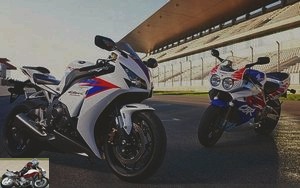
Over the years, the CBR has therefore received a number of major developments (out of 7 vintages in total), both aesthetic and technological. The 1994-1999 opus saw its displacement increased to 916 cm3 and its frame modified. 2000-2001 models take a big leap forward with 929cc with PGM-FI injection and an entirely new chassis.
Lighter and more powerful, the 2002-2003 machines increase to 954 cm3 and improve their aerodynamics. The lines are tense, aggressive. The 2004-2005 and 2006-2007 CBR-RRs are constantly evolving towards an angular and racing style. The exhaust migrates under the saddle, the banana swingarm becomes lighter and the engine climbs to 998cc. Important aesthetic break for the years 2008-2011. The front is short, almost vertical and clashes positively with the competition. The 999 cm3 is dressed in a silencer on the right side, almost under the machine, with flat shapes. New perimeter frame, assisted clutch to lower gears without rear wheel locking and C-ABS coupled braking available.
Discreet developments
The all-new 2012 CBR 1000 RR offered for testing in Portugal at the Portimao circuit builds on this prestigious heritage, with complete discretion.
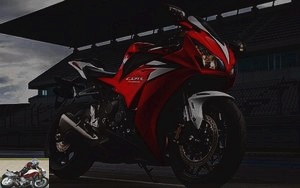
Presenting a more dynamic front design, a compromise between sensuality and sporty appearance, it is notably equipped with new damping technologies and a unique speedometer unit. Completely digital, large and complete, despite its digital design, it gives pride of place to ergonomics. A large bar-graph tachometer with 4 fairly readable display modes and a tachometer with thick numbers alongside a gear indicator. On the right side, a number of information is displayed over 3 lines. From the most common: engine temperature, average consumption, odometer and partial, to the less common: stopwatch with multiple recorded laps. This is controlled via the starter. A shift-light comprising 5 configurable progressive flashing diodes overhangs the whole. Also new, a second-generation electronic power-assisted steering damper prevents the risk of high-speed steering..
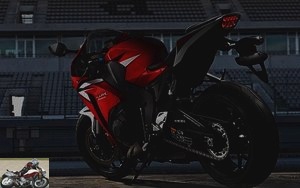
The Showa suspensions mark a real difference with the previous model. The 43mm inverted big piston fork, adjustable in any direction, features a unique construction with a larger damping volume. The hydraulic pressure generated is now lower during the compression and expansion phases. The damping, which is smoother, maximizes tire contact with the ground, providing a better feeling of the front end and improved stability during intensive braking phases.
The shock absorber is of the "Balance Free Rear Cushion" type, also configurable at will, designed according to a double-tube architecture (the body of the shock absorber plus a second inner tube) instead of the conventional single tube. Thus, the piston no longer has valves, the damping function being generated by the passage of the oil in a separate element. This system must offer even more precise reactions and therefore improved traction through more constant tire / ground contact..
These two high-end suspension equipment also offer a superb finish..
The impressive and elegant swingarm in matt black color responds to the slender curve of the frame, in the same shade. We will also admire the new 12-spoke rims (compared to 3 previously) for more rigidity over the entire surface. These fit new Bridgestone Sport / Road S20 tires as standard..
Our test will take place in 4 sessions. The first two with this rise, the following two will see the CBR equipped with Sport rubber: R10. Discreet but charming, this hyper sport Honda is waiting for its rider.
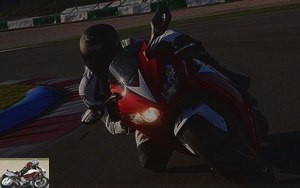
In search of control…. partiel
Surface treatment, color contrast of the upper suspension plates, elegant lines, successful aesthetic gestures (air intake vents near the headlights, muffler under the engine….) …. the CBR 2012 ensures its plastic in the smallest details. Less ostentatious than others, it is all the more attractive. Compact, the Japanese can contain its weight with its 200 kilos in running order (211 with the C-ABS) and remains welcoming for a hyper sport. Without being comfortable, the saddle is not a board either, and the space for the larger one is acceptable. Switched to the half-handlebars, we admire the upper triple clamp and the blue adjustment systems of the fork. The speedometer initializes and Hamamatsu’s 4 cylinder rumbles loudly.
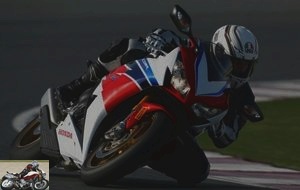
The first two warm-up laps take place behind a competition marshall: the Australian supersport world champion Karl MUGGERIDGE…. The Honda is docile, and its cycle part precise and smooth. Once the tires have warmed up, it’s time to let go of the cavalry. With caution. There is no traction control on this machine. The philosophy of the CBR borders on asceticism on this point. The path of total control, unique to that of a samurai, is intended for a segment of sophisticated users. The 178 hp but above all the 112 Nm of torque at 8,500 rpm (in free version, possible in France in 2013 …) give the Bridgestone S20 a lot of trouble. Their rather road profile, with the high notching rate, does not adapt well to the exuberance of the engine. This one, revised for this vintage, now delivers its breathtaking performances in a perfectly constant manner. But, deliberately consensual, the default profile of the suspensions is too road. So things move nicely on the angle and during the different phases of muscular riding. The figures of speech then oscillate between moderate sliding and straightforward comma. Punctuation when calling others: exclamations and interrogatives. In fact, both the less seasoned and the more experienced seek performance and safety. And the choice not to equip its flagship model with traction assistance puts this model at odds with its competitors.
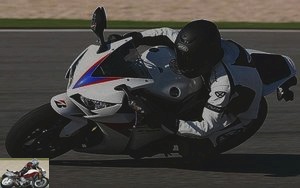
These first two sessions in original installation and tuning do not put the 2012 CBR in value. However, the steering does not lock too much when applying the brakes at the angle, allowing for the correction of overly optimistic trajectories. Fortunately, the second part of the program gives a different face to the enfant terrible of the winged firm.
R10 sport rubber and with firmer suspension settings, the CBR 1000 RR is sharper and more precise. No more crosses, impromptu posturing. Its natural softness is at the service of remarkable efficiency. You can just feel the rear envelope still surfing gently on the asphalt when going around on the couple.

The pins are negotiated to the millimeter and we even find ourselves oversteer during the first evolutions. Throwing itself straight into each bend, the machine bursts out of the bends and rears up when it comes up on the hilly Portuguese circuit. The Honda unit impresses with availability and strength, both at mid-throttle and at the top of the tachometer. Limited to 13,000 rotations / minute, the shiftlight calls the pilot to order, according to the lyrical flights of the 4 cylinders. We therefore regret the absence of a shifter allowing you to shift gears on the fly.
The steering damper often operates during heavy acceleration, keeping the bike in line without giving off a cold sweat. The front sheds but invariably falls back smoothly and in line.
It’s time to grab the brakes … rather THE front brake lever. Controlling the entire system in the optional C-ABS version, it sits the bike on the rear during deceleration, effectively limiting any rear wheel sweeps. One finger is enough to give the impression of sinking into the asphalt of the track. Power, progressiveness and endurance are on the menu. The new fork keeps pace without failing. Extremely stiff and finally homogeneous in damping, the CBR is easy and, on the angle, gives an excellent feeling of control in large (very) fast turns. The highly efficient clutch assist allows gear to be stacked without qualms at the end of a straight line. Perfectly neutral, this principle supports braking as much.
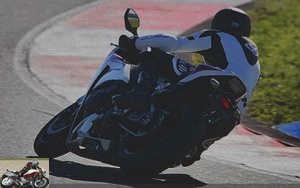
Conclusion
This anniversary version did not unbox any electronic artillery and miscellaneous support in the face of stiff competition in the segment. Always effective and pleasant, easy but powerful, its softness does not mask the explosive performance of the machine for long. It lacks electronic assistance, not so much in absolute terms, as vis-à-vis its rivals. Total control has its limits. Perfectly balanced in its efficiency / theoretical mastery ratio, this CBR 1000 RR cannot give an average pilot the quintessence of its dynamic possibilities. Others offer it more easily.
Kawasaki ZX-10R ABS and BMW S 1000 RR, with breathtaking performance, are fitted with state-of-the-art electronics. Offered respectively at € 16,899 and € 15,900 (€ 17,570 with ABS, DTC and shifter), they meet the Aprilia RSV 4 APRC, a formidably efficient machine, equipped with a plethora of assistance and priced at 16,490 €.
But the beauty of Hamamatsu has for herself, and logically, the price argument. At € 13,490 (promotion at € 13,390), it is the cheapest of the sports cars. Will this parameter be sufficient to dispense with effective aids limiting the risks of destroying his dear mount??
Strong points
- Engine performance and elasticity
- Cycle part
- Powerful braking
- Easy to use
- Finishes
Weak points
- Lack of some electronic assistance
Competitors: Aprilia RSV4, BMW S1000RR, Ducati 1198, Kawasaki ZX10R, Suzuki GSXR-1000, Yamaha R1
The technical sheet of the CBR 1000RR
Related articles
-
Honda CBR 1000 RR Fireblade test
The era of e-Total Control A quarter of a century has seen the evolution of one of the most efficient and unique sports cars in the segment: the CBR…
-
Kawasaki Versys 1000 SE motorcycle test
3rd evolution for the shock road trail hybrid 4 cylinders in line, 1,043 cm3, 120 hp and 102 Nm, KECS electronic suspensions, 257 kg, 16,899 euros…
-
Honda Varadero 1000 XLV motorcycle test
Maxi-Trail with a road vocation The Honda XL 1000 V Varadero, which appeared in 1998, is the heir to the famous Africa Twin … but the manufacturer has…
-
Flatteries of flat Appeared forty years ago (already!), The Honda 1000 GoldWing was the first behemoth produced in large series. A limousine on two…
-
The small large gas turbine The brand’s historic sports car, the CBR 600 RR is a sure bet for efficiency and performance. Rather than the ultimate quest…
-
Kawasaki Ninja 1000 SX motorcycle test
Compromise without compromise 4 cylinders of 1,043 cm3, 142 hp and 111 Nm, 235 kg, from 14,349 euros In 2010, Kawasaki presented its first Z1000SX, a…
-
MV Agusta Brutale 1000 Serie Oro test
0 to 100 km / h in 2.9 seconds! Muscular test at over 300 km / h ! 4 cylinders of 998 cm3, 208 hp and 115 Nm, 186 kg dry, 300 copies, 42,990 euros At the…
-
Authentic avant-garde 4 cylinders of 999 cm3, 152 hp, 106 Nm, 214 kg full made, 19 liter tank 45 years old ! The GSX saga began in 1976 with the GS 750,…
-
The unfinished future The brand with three tuning forks, wishing to prove its lead in terms of technology and innovation, unveiled its 1000 GTS at the…
-
Honda renews its big roadster. Retro, sporty, or both ? 4 cylinders in line, 998 cm3, 145 hp at 10,500 rpm, 104 Nm at 8,250 rpm, 212 kilos with full…